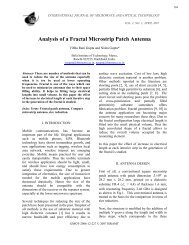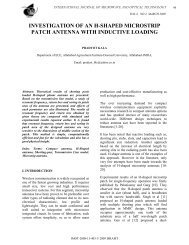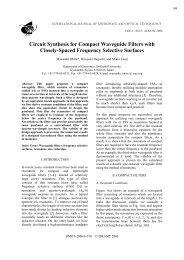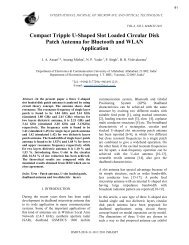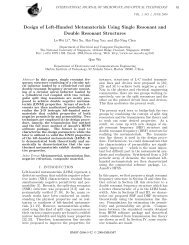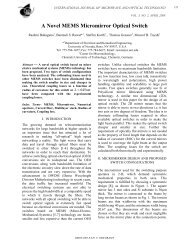Microwave Phase Shifter with Electromagnetic Signal ... - Ijmot.com
Microwave Phase Shifter with Electromagnetic Signal ... - Ijmot.com
Microwave Phase Shifter with Electromagnetic Signal ... - Ijmot.com
Create successful ePaper yourself
Turn your PDF publications into a flip-book with our unique Google optimized e-Paper software.
INTERNATIONAL JOURNAL OF MICROWAVE AND OPTICAL TECHNOLOGY<br />
IJMOT-2006-4-21 © 2006 ISRAMT<br />
VOL. 1 , NO. 1 , JUNE 2006<br />
<strong>Microwave</strong> <strong>Phase</strong> <strong>Shifter</strong> <strong>with</strong> <strong>Electromagnetic</strong> <strong>Signal</strong><br />
Coupling in Silicon Bulk Technology<br />
Stefan Leidich 1 *, Sebastian Voigt 1 , Steffen Kurth 2 , Karla Hiller 1 , Thomas Gessner 1,2<br />
1 Chemnitz University of Technology, Center for Microtechnologies, Chemnitz, 09107, Germany<br />
2 Fraunhofer IZM, Dept. Multi Device Integration, Chemnitz, 09126, Germany<br />
Tel: +49 371 531 35500; E-mail: stefan.leidich@zfm.tu-chemnitz.de<br />
Abstract- This contribution presents a Distributed<br />
MEMS Transmission Line (DMTL) phase shifter<br />
for the 24 GHz ISM band fabricated in silicon bulk<br />
technology. Using this technology enables the<br />
suspension of all capacitive loads on one movable<br />
plate and therefore allows wide range analog and<br />
homogeneous tuning. To avoid <strong>com</strong>monly used<br />
metallic feed-throughs for signal connection, an<br />
electromagnetic signal coupler guides the<br />
microwave signal non-galvanically from printed<br />
circuit board level, through the chip substrate into<br />
the MEMS device. The first available prototypes of<br />
the phase shifter are characterized to provide<br />
50°/dB loss normalized differential phase shift at<br />
24 GHz. The achievable normalized insertion loss<br />
of the coupling structure has been determined <strong>with</strong><br />
0.13 - 0.17 dB.<br />
Index Terms- RF-MEMS, phase shifter, coupler,<br />
coplanar waveguide.<br />
I. INTRODUCTION<br />
Many microwave and millimeter-wave circuits<br />
using micro electro mechanical system (MEMS)<br />
devices have demonstrated outstanding RF<br />
performance and low DC power consumption.<br />
Within regards to mechanic actuation, the<br />
majority of proposed RF-MEMS are digitally<br />
actuated devices. The fabrication of analog<br />
adjustable <strong>com</strong>ponents like Distributed MEMS<br />
Transmission Line (DMTL) phase shifters<br />
requires several equal, tunable capacitances<br />
loading a transmission line [1, 2]. Using surface<br />
technology for the fabrication of variable<br />
capacitors seems to be difficult, since the tuning<br />
ratio is limited to low numbers [3] and the<br />
mechanical characteristics of <strong>com</strong>monly used<br />
double-clamped beams strongly depend on<br />
residual stress and Young’s modulus of thin films<br />
[2]. It can be shown that differences between<br />
individual loads result in local impedance<br />
variations and cause higher reflection losses.<br />
Recent publications on analog tunable MEMS<br />
capacitors in configurations much different from<br />
switches using polycrystalline silicon have<br />
demonstrated high tuning range <strong>with</strong> very low<br />
actuation voltage [4]. Because of long signal<br />
lines made of polycrystalline silicon partly<br />
covered <strong>with</strong> gold the quality factors and the self<br />
resonance frequencies of these devices are<br />
<strong>com</strong>parably low. The focus of this work is to<br />
demonstrate the capabilities of silicon bulk<br />
technology for the fabrication of analog tunable<br />
DMTL phase shifters. In a second part of the<br />
paper an impedance matched electromagnetic<br />
signal coupler is described. The coupler connects<br />
the MEMS phase shifter to the printed circuit<br />
board non-galvanically and therefore avoids<br />
technologically challenging metallic feedthroughs<br />
used for signal connection of packaged<br />
devices [5].<br />
II. DMTL PHASE SHIFTER IN SILICON<br />
BULK TECHNOLOGY<br />
For the design of analog DMTL phase shifters<br />
the silicon bulk technology offers advantages<br />
<strong>com</strong>pared to surface technologies. The capability<br />
of etching structures into the single crystalline<br />
silicon, in contrast to the limitation of solely<br />
depositing and structuring thin films, allows the<br />
fabrication of actually 3-dimensional structures.<br />
This enables the design of actuation mechanisms<br />
that <strong>com</strong>monly suspend all capacitive loads and<br />
therefore minimize capacitance variations<br />
between the individual elements. Further on, the<br />
1
INTERNATIONAL JOURNAL OF MICROWAVE AND OPTICAL TECHNOLOGY<br />
physical separation of actuation electrodes and<br />
transmission line conductors results in a high<br />
tuning ratio and provides intrinsically high<br />
isolation between DC and microwave lines [6].<br />
The top view in Fig. 1 and the corresponding<br />
cross section in Fig. 2 show the two wafer<br />
concept of the phase shifter. Six beam springs<br />
suspend a structured movable plate forming 25<br />
capacitive loads. In contrast to the referenced<br />
approach [2] these loads are capacitively coupled<br />
to the ground plane of a high impedance coplanar<br />
waveguide (CPW) which is situated on the<br />
bottom wafer. The coupling capacitances change<br />
<strong>with</strong> the moving bridges. As can be seen in Fig. 2<br />
the actuation electrodes on the bottom wafer are<br />
placed in a cavity to enhance the tunability of the<br />
functional bridge gap. The CPW is suspended on<br />
a 30 µm silicon membrane to reduce dielectric<br />
loss and to achieve high unloaded impedance<br />
despite the high relative permittivity of silicon.<br />
Actuation<br />
electrode<br />
<strong>Signal</strong><br />
coupler<br />
Metallized<br />
bridge<br />
A<br />
B B<br />
Fig. 1. Schematic top view<br />
A - A<br />
A<br />
Metallized bridge<br />
(capacitive load)<br />
Suspended coplanar<br />
waveguide<br />
Movable<br />
plate<br />
Symmetry plane<br />
Top wafer<br />
Bottom wafer<br />
Fig. 2. Schematic cross section (cut A-A)<br />
Beam<br />
spring<br />
Coplanar<br />
waveguide<br />
The tunable capacitive loading introduced by the<br />
metal bridges Cb divided by bridge spacing s<br />
IJMOT-2006-4-21 © 2006 ISRAMT<br />
VOL. 1, NO. 1, JUNE 2006<br />
represents an additional contribution to the CPW<br />
per-unit length capacitance Cl and influences the<br />
phase velocity as well as the line impedance. The<br />
per-unit length inductance Ll remains unaffected.<br />
These assumptions are valid up to a very high<br />
upper frequency limit caused by Bragg<br />
reflections at periodic structures [2]. Following<br />
(1) the proportionality between differential phase<br />
shift ∆Ф per line length l and frequency f<br />
evidences the true time delay characteristics of<br />
the DMTL concept. The high unloaded line<br />
impedance of the membrane suspended CPW<br />
(low Cl) results in high differential phase shift.<br />
For a higher difference in phase velocities the<br />
differential phase shift increases. Hence, the<br />
tuning ratio of the capacitive loads determines<br />
the maximum time delay. However, beside<br />
certain physical restrictions, the primary<br />
limitation results from highest acceptable VSWR<br />
caused by impedance mismatch between the<br />
phase shifter and the feed line.<br />
∆Φ<br />
2πf<br />
⋅l<br />
=<br />
⎛ Cb,<br />
Ll<br />
⎜Cl<br />
+<br />
⎝ s<br />
max<br />
⎞<br />
⎟<br />
⎠<br />
−<br />
⎛ C b,<br />
Ll<br />
⎜Cl<br />
+<br />
⎝ s<br />
⎞<br />
⎟<br />
⎠<br />
(1)<br />
Designing RF-MEMS devices <strong>with</strong> <strong>com</strong>plex<br />
geometries requires careful considerations of<br />
<strong>com</strong>ponent interaction. While <strong>com</strong>monly used<br />
2.5-dimensional simulation algorithm like the<br />
Method of Moment (MoM) are good for basic<br />
design considerations, only full wave 3dimensional<br />
simulations can provide an insight<br />
into more <strong>com</strong>plex dependencies. A six-bridge<br />
subsection of the phase shifter has been<br />
implemented in a Finite Difference Time Domain<br />
(FDTD) simulator. The simulation in time<br />
domain allows the visualization of the actual<br />
wave propagation and makes analyzing of<br />
discontinuities at material boundaries possible.<br />
Fig. 3 shows exemplarily the magnitude of the<br />
electric field in between the CPW and the<br />
bridges. According to expectations, the field is<br />
concentrated between the center conductor and<br />
the metallized bridges. In consequence, the<br />
reasonable overlap length of the bridge and the<br />
ground plane is limited, since the outside of the<br />
min<br />
2
INTERNATIONAL JOURNAL OF MICROWAVE AND OPTICAL TECHNOLOGY<br />
bridges are less penetrated by field and therefore<br />
do not provide much coupling.<br />
Excitation port<br />
(gaussian pulse)<br />
<strong>Phase</strong> shifter<br />
sub section<br />
(6 bridges)<br />
Receiving<br />
port<br />
0 dB<br />
-70 dB<br />
Fig. 3. Magnitude of E-field simulated by FDTD<br />
(structures set to invisible)<br />
The design was optimized <strong>with</strong> respect to phase<br />
shift per line length. The fabricated phase shifter<br />
consists of 25 bridges <strong>with</strong> a spacing of 300 µm<br />
and a width of 100 µm. For the dimensions listed<br />
in Table 1 the FDTD and the MoM simulation<br />
predict a differential phase shift of 17°/mm line<br />
length at 24 GHz by tuning the bridge gap from<br />
4 µm to 2 µm. This corresponds to a return loss<br />
of better than 25 dB caused by impedance<br />
mismatch. Considering metal losses and the bulk<br />
conductivity of high resistance silicon<br />
(ρ = 3000 Ωcm) the simulated insertion loss of<br />
the CPW located on a 30 µm membrane is<br />
0.8 dB/cm at 24 GHz. Due to the wide range<br />
tunability of the bridge gap the phase shift can be<br />
increased if one can tolerate more return loss. By<br />
applying the DC bias voltage of 0 - 45 V the<br />
bridge gap can be tuned from 6 - 1 µm. The<br />
actuation voltage of 45 V is chosen under the<br />
constraint that the movable plate’s maximum<br />
displacement due to gravity is less than 5% of the<br />
bridge gap.<br />
Table 1: Dimensions of the phase shifter<br />
Bridge width 100 µm<br />
Bridge spacing 300 µm<br />
Tunable bridge gap 6 - 1 µm<br />
Number of bridges 25<br />
Center conductor width 175 µm<br />
Ground gap 175 µm<br />
IJMOT-2006-4-21 © ISRAMT 2006<br />
VOL. 1, NO. 1, JUNE 2006<br />
III. COPLANAR ELECTROMAGNETIC<br />
SIGNAL COUPLER<br />
The successful integration of RF-MEMS into<br />
microwave circuits not only depends on RF<br />
performance. For industrial acceptance, the<br />
devices need to provide high reliability and<br />
convenient handling known from their<br />
semiconductor counterparts. Many studies on<br />
MEMS have shown that hermetic sealing is<br />
important for long time stability and insensitivity<br />
against changing environmental conditions like<br />
temperature and humidity [3]. A recurring<br />
problem related to packaging is the signal<br />
connection between the microwave circuit and<br />
the insight of the die. Flip-chip bonding demands<br />
for technologically challenging through wafer<br />
vias, whereas many in-plane feed-trough<br />
techniques require additional bond wires for final<br />
circuit connection [7]. In contrast to<br />
semiconductor devices, MEMS are potentially<br />
sensitive to mechanical stress. Solder connections<br />
to substrates <strong>with</strong> much different thermal<br />
expansion coefficients introduce high mechanical<br />
stress and might cause undesirable deflection and<br />
bending of the moveable structures. The<br />
electromagnetic signal coupler, shown in Fig. 4,<br />
connects the MEMS phase shifter to the printed<br />
circuit board non-galvanically using<br />
electromagnetic coupling and low stress epoxy<br />
adhesive mounting.<br />
Port 1<br />
(feed line)<br />
Port 2<br />
(phase shifter)<br />
EM coupling<br />
MEMS device<br />
Printed circuit<br />
board<br />
Fig. 4. Concept of coplanar electromagnetic signal<br />
coupler<br />
3
INTERNATIONAL JOURNAL OF MICROWAVE AND OPTICAL TECHNOLOGY<br />
Coupling between adjacent transmission lines is<br />
well known and extensively treated in many text<br />
books. A surface-to-surface transition through a<br />
chip substrate has been shown in [8]. In the case<br />
of MEMS devices the coupler needs to be<br />
integrated in a geometry mostly predefined by<br />
technology aspects. Fig. 5 shows the cross<br />
section through the chip of Fig. 1.<br />
The section outside of the chip contains the feed<br />
line. The frame is required for wafer bonding and<br />
should provide a certain width. In contrast to the<br />
thin membrane, the solid high permittivity silicon<br />
of the bottom wafer enhances the coupling.<br />
Consequently the best position for the coupler is<br />
in between the frame and the phase shifter.<br />
Material stack:<br />
Top wafer<br />
Gold metallization<br />
Bottom wafer<br />
Copper cladding<br />
Printed circuit<br />
board<br />
Outside of<br />
chip<br />
Frame Coupler<br />
section<br />
<strong>Phase</strong> shifter<br />
unit<br />
Fig. 5. Schematic cross section (cut B-B of Fig. 1)<br />
The synthesis of couplers is often done by<br />
iterative use of analysis techniques. Conventional<br />
even- and odd-mode techniques require<br />
geometrical symmetry. The material stack<br />
according to Fig. 5 does not allow symmetry,<br />
since the printed circuit board does not have an<br />
electrically equal counterpart above the coupler.<br />
Hence, the configuration used in this design is<br />
called asymmetric and has been described by [9]<br />
using the c- and π-mode analysis technique. For<br />
setting up an analytically described model of the<br />
2-port network the self- and mutual-capacitances<br />
Cmn and inductance Lmn have to be derived. This<br />
can be done by several ways. In ref. [10] the<br />
parameters are calculated by conformal mapping<br />
using the <strong>com</strong>plete elliptic integral of the second<br />
kind. Even though conformal mapping is an exact<br />
solution, the method can not consider finite<br />
conductor thickness. Finite Element Method<br />
(FEM) simulations of a multi conductor<br />
IJMOT-2006-4-21 © 2006 ISRAMT<br />
VOL. 1, NO. 1, JUNE 2006<br />
configuration in a 2-dimensional cross-section<br />
only provide capacitance matrices. However,<br />
performing the simulation twice, first <strong>with</strong>in the<br />
given dielectric material configuration and<br />
second <strong>with</strong> the dielectric material replaced by air<br />
(εr = 1), the knowledge about phase velocity in<br />
vacuum c0 yields the missing inductance matrix<br />
according to (2) [11].<br />
⎡L<br />
⎢<br />
⎣L<br />
11<br />
21<br />
L12<br />
⎤ 1 ⎡C<br />
= 2<br />
L<br />
⎥ ⎢<br />
22 ⎦ c0<br />
⎣C<br />
11<br />
21<br />
C<br />
C<br />
12<br />
22<br />
⎤<br />
⎥<br />
⎦<br />
−1<br />
air<br />
(2)<br />
The derived capacitance and inductance matrices<br />
are used for the calculation of the c- and π-mode<br />
impedances and phase velocities [12] and finally<br />
for the calculation of ABCD- or S-parameters [9].<br />
In contrast to a symmetric coupler the<br />
asymmetric coupler provides different<br />
characteristics at both of its ports. This behavior<br />
can be analyzed using the concept of image<br />
impedances Zi known from filter design. Eq. (3)-<br />
(4) [13] describe the image impedance at port one<br />
and two. The arguments of the equation are the<br />
elements of the ABCD-matrix. According to the<br />
definition, the image impedance Zi,1 represents<br />
the input impedance at port one, if port two is<br />
terminated <strong>with</strong> Zi,2 and vice versa. Eq. (5) [13]<br />
yields an equivalent transmission coefficient γeq<br />
of the 2-port network. The primary objective of<br />
the coupler design is to find a configuration<br />
where both ports are terminated <strong>with</strong> their image<br />
impedance and where the equivalent transmission<br />
coefficient is purely imaginary. On that condition<br />
the coupler is equivalent to matched and lossless<br />
transmission line, which represents an ideal<br />
signal connection.<br />
Z i , 1 = AB CD<br />
(3)<br />
Z i , 2 = BD AC<br />
(4)<br />
1<br />
cosh AD<br />
−<br />
γ =<br />
(5)<br />
eq<br />
Using the method outlined above, the coupler<br />
layout can be designed. The length of the<br />
coupling section is chosen to meet the center<br />
4
INTERNATIONAL JOURNAL OF MICROWAVE AND OPTICAL TECHNOLOGY<br />
frequency of 24 GHz. Comprehensive analyses<br />
have shown that under the constraint of the given<br />
dielectric material stack and meaningful<br />
conductor dimensions, there is no situation where<br />
both impedances are equal to the characteristic<br />
impedance Z0 = 50 Ω. The high permittivity of<br />
silicon and of most CPW-suited printed circuit<br />
board materials results in lower impedance<br />
values. However, choosing proper conductor<br />
dimensions, the inherent transformation ability of<br />
asymmetric couplers can be used to achieve a<br />
matched condition at port two [14]. Referring to<br />
Fig. 6, at the center frequency Zi,1 and Zi,2 are<br />
different. While Zi,1 has a maximum value of<br />
much below 50 Ω, Zi,2 is matched to Z0. A<br />
network like this can be easily matched by a λ/4transformer<br />
placed in between the feed line and<br />
the coupler. With respect to Fig. 5, the high<br />
permittivity silicon entirely around the conductor<br />
below the frame allows the fabrication of low<br />
impedance lines, suitable for matching<br />
Zi,1 ≈ 25 Ω to Z0.<br />
Re Zi<br />
in Ω<br />
Fig. 6. Image impedances at the coupler ports<br />
Feed line<br />
Excitation port<br />
(gaussian pulse)<br />
Transformer<br />
Zi1<br />
Zi<br />
2<br />
Receiving<br />
port<br />
0 dB<br />
-70 dB<br />
f in GHz<br />
Connection to<br />
phase shifter<br />
unit<br />
Fig. 7. Magnitude of current density simulated by<br />
FDTD (dielectric material set to invisible)<br />
IJMOT-2006-4-21 © 2006 ISRAMT<br />
VOL. 1, NO. 1 , JUNE 2006<br />
The coupler layout is optimized by full-wave<br />
FDTD and MoM simulations. The FDTD<br />
simulation results of a coupler <strong>with</strong> dimensions<br />
according to Table 2 are visualized in Fig. 7. At<br />
the center frequency of 24 GHz, the<br />
electromagnetic wave travels from the feed line<br />
on printed circuit board to the elevated CPW on<br />
silicon <strong>with</strong> a return loss of better than 20 dB and<br />
approximately 10% relative bandwidth.<br />
The influence of possible mounting<br />
imperfectness <strong>with</strong> respect to relative<br />
displacement error has been studied by<br />
simulation as well. The coupler response is<br />
almost unaffected by relative position error of up<br />
to ±50 µm in x- and y-direction. Commercially<br />
available pick-and-place automats provide less<br />
than 20 µm positioning error. Tolerances in zdirection<br />
causing an air gap between the<br />
conductor and the silicon have much stronger<br />
influence, since mode impedances and phase<br />
velocities change significantly. A possible origin<br />
of an air gap is for example the surface roughness<br />
of the copper cladding. Since simulations in the<br />
domain of surface properties are very difficult,<br />
the influence is initially neglected and then<br />
experimentally analyzed.<br />
Table 2: Dimensions of the fabricated coupler<br />
Strip width 150 µm<br />
Ground gap 250 µm<br />
Ground width 250 µm<br />
Coupler length 850 µm<br />
Substrate thickness (silicon) 100 µm<br />
PCB thickness (Rogers TMM10i) 380 µm<br />
III. FABRICATION IN SILICON BULK<br />
TECHNOLOGY<br />
The phase shifter is fabricated in silicon bulk<br />
technology using anisotropic wet etching,<br />
reactive ion etching (RIE), silicon oxide and<br />
silicon nitride passivation and physical vapor<br />
deposition (PVD) of gold conductors. After the<br />
individual fabrication, the bottom and the top<br />
wafer are joined by silicon direct bonding.<br />
The processing sequence of the bottom wafer is<br />
schematically shown in Fig. 8. All cavities are<br />
structured by using KOH anisotropic wet etching.<br />
5
INTERNATIONAL JOURNAL OF MICROWAVE AND OPTICAL TECHNOLOGY<br />
Etching in two depth levels from the backside is<br />
performed, since the desired substrate thickness<br />
of 100 µm (cp. Table 2) is too thin for wafer<br />
handling during processing. The thick frame is<br />
finally removed by dicing at the marked cutting<br />
lines. For <strong>com</strong>pensation of residual stress and for<br />
isolation the conductors are deposited on 1 µm of<br />
silicon oxide. To avoid adverse conducting<br />
channels, the silicon oxide is removed between<br />
the RF conductors [10].<br />
Thermal oxidation of<br />
250 µm high<br />
resistance silicon<br />
wafer<br />
Etching of actuation<br />
gap<br />
CVD of Si3N4 and<br />
membrane definition<br />
Etching to 100 µm<br />
residual chip thickness<br />
Sputtering and<br />
lithographic<br />
structuring of gold<br />
metallization<br />
Removing SiO2<br />
between conductors<br />
(cutting lines drawn<br />
in)<br />
Fig. 8. Fabrication sequence of the bottom wafer<br />
Etching of actuation<br />
gap<br />
Definition of SiO2<br />
strip for metal<br />
deposition<br />
Dry etching of<br />
movable structure<br />
using photo resist as<br />
mask<br />
IJMOT-2006-4-21 © 2006 ISRAMT<br />
VOL. 1, NO. 1, JUNE 2006<br />
Etching 150 µm<br />
silicon using Si3N4 for<br />
passivation<br />
Etching of Si3N4 prior<br />
to silicon perforation<br />
Etching of SiO2 and<br />
metallization of<br />
bridges by using PVD<br />
and shadow mask<br />
Fig. 9. Fabrication sequence of the top wafer<br />
The process scheme of the top wafer fabrication<br />
is shown in Fig. 9. After etching the actuation<br />
gap, the movable structure is shaped by RIE and<br />
released by wet etching from the back side. The<br />
localized metallization of the bridges is achieved<br />
using PVD and a shadow mask. Fig. 10 shows a<br />
SEM micrograph of the rung-shaped metal<br />
bridges. The oxide layer underneath the metal<br />
<strong>com</strong>pensates the residual stress of sputtered gold.<br />
Metallized<br />
bridge<br />
Moveable<br />
plate<br />
Beam<br />
Spring<br />
Opening in<br />
shadow<br />
mask<br />
Fig. 10. SEM micrograph of the top wafer (bottom<br />
view)<br />
Sealed packaging on wafer-scale can be achieved<br />
by bonding a cap-wafer onto the top wafer (cp.<br />
Fig. 2). This has not been realized <strong>with</strong>in the first<br />
fabrication, because the accessibility <strong>with</strong> onwafer<br />
probes was desired for separate<br />
characterization of the individual <strong>com</strong>ponents. In<br />
contrast to surface technologies, mechanical<br />
structures fabricated in silicon bulk technology<br />
<strong>with</strong>stand bonding temperatures of at least 400°C<br />
[15] and therefore allow bonding processes like<br />
silicon direct bonding which is well-known for<br />
its excellent sealing properties.<br />
6
INTERNATIONAL JOURNAL OF MICROWAVE AND OPTICAL TECHNOLOGY<br />
IV. MEASUREMENT RESULTS<br />
The fabrication of several prototype designs<br />
allows a separate characterization of the phase<br />
shifter and the signal coupler. Chips <strong>with</strong> the<br />
phase shifter, having only on-wafer probe pads,<br />
can be used to characterize the phase shifter<br />
separately from the couplers. The signal coupler<br />
is characterized <strong>with</strong> chips containing only a<br />
single coupling structure.<br />
A. De-embedding of Device Under Test<br />
Accurate characterization of RF <strong>com</strong>ponents<br />
using on-wafer probes requires exact deembedding<br />
of devices under test (DUT).<br />
Commercially available calibration standards<br />
often result in insufficient accuracy, since<br />
substrate material and conductor configuration of<br />
RF-MEMS and calibration substrates are usually<br />
different. For high accuracy, on-wafer standards<br />
have to be fabricated, assuring best possible<br />
similarity between DUT and calibration standard.<br />
The characterization of the coupler in the setup of<br />
Fig. 11 introduces an additional challenge. Due<br />
to the nature of the signal coupler, the probe<br />
landing pads at both ports are not identical.<br />
Consequently, neither a set of on-wafer<br />
standards, nor a set of PCB-standards is suitable<br />
for de-embedding.<br />
Fig. 11. Photograph of single coupler prototype <strong>with</strong><br />
on-wafer probes<br />
The Multiline Thru-Reflect-Line (TRL)<br />
procedure of the National Institute of Standards<br />
and Technology (NIST) at Boulder, CO allows<br />
using so called adapters. Adapters are 2-port<br />
networks that correct the measurements for a<br />
known error at one port. In this case, the error is<br />
IJMOT-2006-4-21 © 2006 ISRAMT<br />
VOL. 1, NO. 1, JUNE 2006<br />
the difference between the landing pads. The<br />
sequence of calibration starts <strong>with</strong> the<br />
measurement of the on-wafer standards. The<br />
resulting calibration coefficients are applied to<br />
the measured data of the PCB-standards.<br />
Performing a new calibration using the PCBstandards<br />
priorly de-embedded <strong>with</strong> on-wafer<br />
coefficients, yield calibration coefficients that<br />
represent the difference between both sets of<br />
standards. Finally, the calibration coefficients<br />
can be converted to so-called error-boxes which<br />
represent the required adapter [16].<br />
B. Characterization of the <strong>Phase</strong> <strong>Shifter</strong><br />
Fig. 12 shows the fabricated device <strong>with</strong> onwafer<br />
probe pads for characterization of the<br />
phase shifter unit only. First available prototypes<br />
were manually bonded on chip-scale using epoxy<br />
adhesive. This resulted in a higher actuation gap<br />
and non-perfect planarity between the movable<br />
plate and the CPW. In consequence, the<br />
metallized bridges provide inhomogeneous<br />
loading resulting in impedance deviations. The<br />
prototype shows continuously tunable differential<br />
phase shift (Fig. 13) proportional to frequency,<br />
thus representing a true time delay. The measured<br />
differential phase shift for a bias voltage of 50 V<br />
is 5.4°/mm at 24 GHz. The periodic ripples in the<br />
traces of Fig. 13 are caused by frequency<br />
dependence of imperfect impedance match. At<br />
matched condition the figure of merit is about<br />
50° phase shift per 1dB insertion loss at 24 GHz.<br />
This is, yet, a good value <strong>com</strong>pared to <strong>com</strong>peting<br />
structures and principles. Nevertheless, it is<br />
expected that current investigations, in order to<br />
use silicon direct bonding on wafer-scale, yield<br />
better impedance match and significantly higher<br />
differential phase shift.<br />
Fig. 12. Photograph of the fabricated phase shifter<br />
<strong>with</strong> on-wafer probes<br />
7
Fig. 13. Measured differential phase shift at different<br />
bias voltages<br />
C. Characterization of the <strong>Signal</strong> Coupler<br />
INTERNATIONAL JOURNAL OF MICROWAVE AND OPTICAL TECHNOLOGY<br />
Using the de-embedding technique outlined<br />
above, the fabricated coupler shows the expected<br />
transmission behavior (Fig. 14). Due to the<br />
initially approximated effective air gap between<br />
chip and printed circuit board, the center<br />
frequency of about 28 GHz and the impedance<br />
match deviate from specifications. By <strong>com</strong>paring<br />
the measurements <strong>with</strong> modified simulation<br />
models, using different air gap heights, the air<br />
gap could be determined to be dair = 5 µm. The<br />
Smith chart in Fig. 15 shows that the modified<br />
simulation matches amplitude and phase very<br />
exactly over a wide frequency band, which<br />
supports the theory that the air gap is the only<br />
reason for the observed deviations.<br />
Fig. 14. Measured S-parameters of the coupler and<br />
modified simulation results approximating the air gap<br />
Arising objectives of future work are the<br />
optimization of the mounting technique. Layout<br />
modifications <strong>with</strong> respect to coupler length and<br />
transformer dimensions are considered to result<br />
in better matching at the desired center<br />
frequency. Simulated optimizations based on the<br />
IJMOT-2006-4-21 © 2006 ISRAMT<br />
VOL. 1, NO. 1, JUNE 2006<br />
measured numbers predict a loss per transition of<br />
0.28 - 0.43 dB. Applying the method of<br />
normalized losses by subtracting material losses,<br />
the attenuation caused by the structure itself is<br />
expected to be 0.13 - 0.17 dB.<br />
Fig. 15. Smith chart of Fig. 14 graphs<br />
VI. CONCLUSION<br />
A DMTL phase shifter and a coplanar<br />
electromagnetic signal coupler has been<br />
designed, fabricated, and characterized. Using<br />
silicon bulk technology enables the design of<br />
truly 3-dimensional structures and the<br />
implementation of actuation mechanisms that<br />
<strong>com</strong>monly suspends all capacitive loads on one<br />
movable plate. It is expected that the figure of<br />
merit of 50°/dB loss normalized differential<br />
phase shift can be increased by using wafer<br />
bonding. The low insertion loss and the<br />
considerably low introduced mechanical stress<br />
makes the electromagnetic coupler <strong>with</strong> epoxy<br />
adhesive mounting a promising alternative for<br />
signal connection of stress sensitive RF-MEMS.<br />
8
INTERNATIONAL JOURNAL OF MICROWAVE AND OPTICAL TECHNOLOGY<br />
ACKNOWLEDGMENT<br />
The authors appreciate the kind support of Dr. B.<br />
Rawat during preparatory studies to this work at<br />
the University of Nevada, Reno. They also thank<br />
Dr. W. Weidmann <strong>with</strong> InnoSenT GmbH,<br />
Germany for providing measurement equipment.<br />
REFERENCES<br />
[1] A. S. Nagra and R. A. York, “Distributed analog<br />
phase shifter <strong>with</strong> low insertion loss,” IEEE Trans.<br />
<strong>Microwave</strong> Theory and Tech., Vol. 47, pp. 1705-<br />
1711, Sept. 1999.<br />
[2] N. S. Baker and G. M. Rebeiz, “Distributed<br />
MEMS True-Time Delay <strong>Phase</strong> <strong>Shifter</strong>s and<br />
Wide-Band Switches,” IEEE Trans. <strong>Microwave</strong><br />
Theory and Tech., vol. 46, No. 11, pp. 1881-1890,<br />
Nov. 1998.<br />
[3] G. M. Rebeiz, RF-MEMS – Theory, Design, and<br />
Technology, J. Wiley & Sons, New Jersey, 2003<br />
[4] M. Bakri-Kassem and R. R. Mansour, “High<br />
tuning range parallel plate MEMS variable<br />
capacitors <strong>with</strong> array of supporting beams,” 2006<br />
IEEE MEMS. Dig., Vol. 1, pp. 666-669, Jan. 2006.<br />
[5] B.-W. Min and G. M. Rebeiz, “A low-loss siliconon-silicon<br />
DC-110 GHz resonance-free package,”<br />
IEEE Trans. <strong>Microwave</strong> Theory and Tech., Vol.<br />
54, no. 2, pp. 710-716, Feb. 2006.<br />
[6] D. Girbau and A. Lazaro, “Extended tuning range<br />
RF mems variable capacitors using electrostatic<br />
and electrothermal actuators,” SPIE Proceedings<br />
Photonics West Microm. and Microfab., pp. 59-<br />
70, Jan. 2004.<br />
[7] S. Majumder, J. Lampen, R. Morrison, and J.<br />
Maciel, “A packaged, high-lifetime ohmic MEMS<br />
RF switch,” 2003 IEEE MEMS. Dig., Vol. 3, pp.<br />
1935-1938, Jun. 2003.<br />
[8] R. Jackson and D. Matolak, “Surface-to-surface<br />
transition via electromagnetic coupling of<br />
coplanar waveguides,” IEEE Trans. <strong>Microwave</strong><br />
Theory and Tech., Vol. 35, pp. 1027-1032, Nov.<br />
1987.<br />
[9] V. K. Tripathi, “Asymmetric coupled transmission<br />
lines in an inhomogeneous medium,” IEEE Trans.<br />
<strong>Microwave</strong> Theory Tech., Vol. 23, No. 9, pp. 734-<br />
739, Sept. 1975.<br />
[10] R. N. Simons, Coplanar waveguide circuits,<br />
<strong>com</strong>ponents, and systems, J. Wiley & Sons, New<br />
York, 2001.<br />
[11] G. Bogdanov and R. Ludwig, “Coupled microstrip<br />
line transverse electromagnetic resonator model<br />
for high-field magnetic resonance imaging,”<br />
Magn. Res. Med., Vol. 47, No. 5, pp. 579-593,<br />
May 2002.<br />
IJMOT-2006-4-21 © 2006 ISRAMT<br />
VOL. 1, NO. 1, JUNE 2006<br />
[12] S. S. Bedair and I. Wolff, “Fast and accurate<br />
analytic formulas for calculating the parameters of<br />
a general broadside-coupled coplanar waveguide<br />
for (M)MIC applications,” IEEE Trans.<br />
<strong>Microwave</strong> Theory Tech., Vol. 37, No. 5, pp. 843-<br />
850, May 1989.<br />
[13] D. M. Pozar, <strong>Microwave</strong> engineering, 3 rd ed., J.<br />
Wiley & Sons, New Jersey, 2004.<br />
[14] E. D. Cristal, “Coupled-transmission-line<br />
directional couplers <strong>with</strong> coupled lines of unequal<br />
characteristic impedances,” IEEE Trans.<br />
<strong>Microwave</strong> Theory Tech., Vol. 14, No. 7, pp. 337-<br />
346, Jul. 1966.<br />
[15] K. Hiller, S. Kurth, N. Neumann, et. al.,<br />
“Application of low temperature direct bonding in<br />
optical devices and integrated systems,” 2003<br />
Micro System Techn. Dig., Vol. 1, pp. 102-109,<br />
Oct. 2003.<br />
[16] D. F. Williams, J. C. M. Wang, and U. Arz, “An<br />
optimal vector-network-analyzer calibration<br />
algorithm,” IEEE Trans. <strong>Microwave</strong> Theory Tech.,<br />
Vol. 51, No. 12, pp. 2391-2401, Dec. 2003.<br />
9


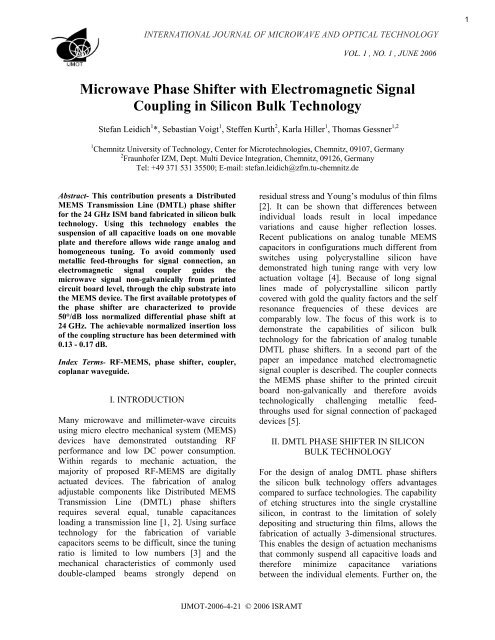
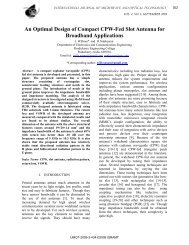
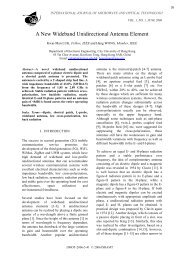
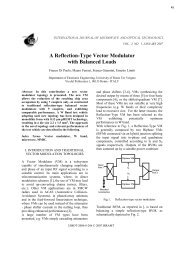
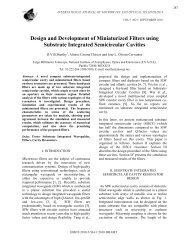
![Full Text[PDF] - Ijmot.com](https://img.yumpu.com/34661120/1/184x260/full-textpdf-ijmotcom.jpg?quality=85)
